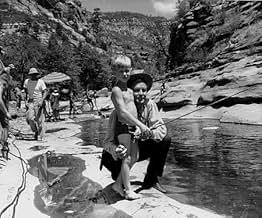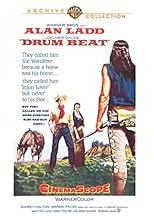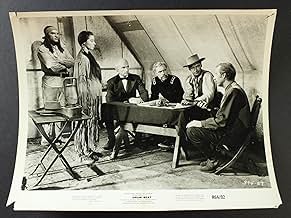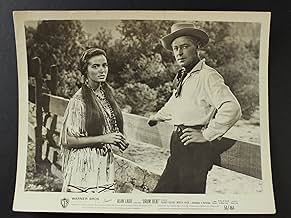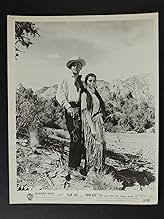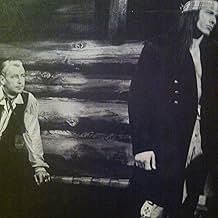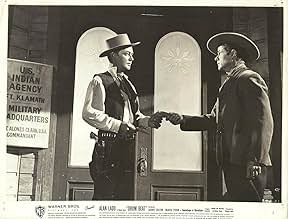Nel 1872, il combattente indiano Johnny MacKay viene nominato commissario per la pace per il territorio della California e dell'Oregon, ma deve affrontare la dura opposizione dei Modoc, rinn... Leggi tuttoNel 1872, il combattente indiano Johnny MacKay viene nominato commissario per la pace per il territorio della California e dell'Oregon, ma deve affrontare la dura opposizione dei Modoc, rinnegati guidati dal loro capo capitano Jack.Nel 1872, il combattente indiano Johnny MacKay viene nominato commissario per la pace per il territorio della California e dell'Oregon, ma deve affrontare la dura opposizione dei Modoc, rinnegati guidati dal loro capo capitano Jack.
- Regia
- Sceneggiatura
- Star
- Modoc Jim
- (as Frank de Kova)
- Capt. Alonzo Clark
- (as George Lewis)
Recensioni in evidenza
Also, for this Bronson fan, that jail cell ending may well be the high point of his acting career. He shows more unforced good humor and naturalness there than any scene I've seen him in. In fact, he easily steals the movie from the rest of the cast, positioning himself as a real Hollywood comer.
This is an A-production from Warner Bros. For example, scope out the well stocked cavalry troop. No corner-cutting there. Then too, lavish use is made of Sedona's familiar red rock locations adding real scenic value. Also, there's a much larger than usual supporting cast of familiar faces, even down to bit parts. Producers Daves and Ladd (uncredited) do a bang-up job assembling the many components.
Surprisingly, for plot developments, the Indians actually get to win a battle and rejoice on- screen. However, the film's impact is damaged by being over-long, probably to accommodate a romantic interest to broaden audience appeal. Then too, Ladd, the actor, appears not nearly as interested in the film as Ladd, the co-producer. Frankly, he looks glum throughout the nearly two-hour running time, and I don't think it's from under-playing the part. Plus having him over-power the muscular, extremely fit looking Bronson is quite a stretch.
Despite these several drawbacks, it's still a good scenic, action flick, the first of director Daves' series of superior Westerns.
Alan Ladd is Indian fighter Johnny Mackay, who is ordered by President Ulysses Grant (Hayden Rorke) to negotiate with the Modoc Indians in an attempt to avert war...
Utterly frustrating! One of the most attractive looking Westerns of the fifties, Daves' movie doesn't quite have the courage of its convictions. The core basis of the film is sound, though as we are told from the off, it features fictionalised enhancements to further dramatic impact. Snatching from a little known part of the Indian Wars from 1872/3 (to be applauded), that of the Modoc Uprising, film is set in 1869 around the Oregon-California border. Plot and story are put in place neatly, where the characters are interesting, the back drop of various Arizona locations is simply in "scope" gorgeous, and the narrative promises some boldness as the first person killed is an innocent woman and the white man protagonists are fuelled by anger and hatred. But...
Unfortunately with a running time of one hour and fifty minutes, many passages of chatter never really expand the characters. Something which is not usually applicable to Delmer Daves when he was on form. We should be getting high grade dramatic worth from the principle players, their conversations should ping with emotion and depth, after being set up as people with voices to be heard, we never get a real grasp of Mackay's inner conflict, or Captain Jack's (Bronson) staunch loyalty to his cause, or even the depth and reasoning of Bill Satterwhite's (Keith) hatred. While there is, as the historians will tell you, a severe dilution of the story to suit the white man's cause. It's hard to believe this is the same director of Broken Arrow from four years earlier! But then Daves wasn't writing the screenplay....
Maybe Daves felt he needed to better the screenplay for Broken Arrow? To show he could put down on the page some "liberal" quality as well as directing? He would prove post Drum Beat that he could "co-write" great Western screenplays (Jubal/White Feather/The Last Wagon), but here on his own he falls short. Not only does it skulk in the shadow of Broken Arrow, it also pales into insignificance to Anthony Mann's brilliant Devil's Doorway, which was also from 1950. You can feel Daves striving for relevance in the mid fifties, but he is trumped by narrative zest elsewhere, a shame since the acting performances and production quality make Drum Beat very watchable.
Visually it's superb, Sedona's various natural beauties are excellently captured by Peverell Marley (The Left Handed Gun/Westbound), while Daves proves adept at utilising the landscapes as part of his action sequences (check out the red rock rifle engagement scene). Young's score is a goodie, blending bombastic beats with ballad strains, and the Warnercolor is gorgeous, one of the better Warnercolor productions that I have seen. Acting wise it's Bronson's movie, physically perfect and featuring a shifty aggressive ebullience that's most appealing. Ladd scores well, too, nicely underplayed at the critical moments, Keith has a thespian quality that suits the role of an Indian hating aggressor, and Elisha Cook provides weasel smarts that make us yearn for his part to have been bigger.
Some have questioned why this isn't better known or worthy of a widespread home format release? The answer is that simply it has more style than substance, and Daves, as much as us Western fans love him, is to blame from a writing perspective. Visually and aurally the film ranks a comfortable 9/10. As a whole, sadly, it rounds out as 6.5/10.
Canby's Cross is a monument erected on the site of the killings, to honor the men lost. On the cross, is inscribed, "Gen Canby USA was murdered here by the Modocs April 11, 1873"
The real Canby was shot in the face. In the movie, it appeared they kept that detail, as you see him clutch his face after the second shot.
The history may be real but it's told from one side of the conflict. This is an old fashion western in more than one way. It definitely has the scenery. Most white folks starting with MacKay are simply trying to keep the peace. The Indians are the trouble makers along with some white settlers. It's an early role for Bronson and he does some fine red-face acting. Alan Ladd is doing very blend acting. It's probably deliberate to give this character the persona of a peace giver. It may be propaganda but it works for the audience of its day. The American government only wants to help the red savage and some just refuse to be civilized.
Lo sapevi?
- QuizActor Charles Buchinsky (his birth name) changed his name to Charles Bronson, using his new moniker for the first time in this film, and remained so for the rest of his acting career.
- BlooperPresident Grant is shown wearing his Army uniform in the White House. This is inaccurate as General Grant resigned his commission in 1869.
- Citazioni
Dr. Thomas: Don't you feel like a murderer?
Johnny MacKay: No, sir.
Dr. Thomas: Shouldn't you?
Johnny MacKay: I've never shot anyone without cause. My job is to protect the wagon train. When somebody shoots at my people, I shoot back.
- ConnessioniFeatured in The Good Life (2007)
I più visti
- How long is Drum Beat?Powered by Alexa
Dettagli
Botteghino
- Budget
- 1.100.000 USD (previsto)
- Tempo di esecuzione
- 1h 51min(111 min)
- Proporzioni
- 2.55 : 1

